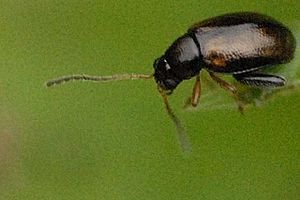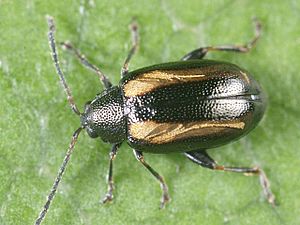Phyllotreta facts for kids
Quick facts for kids Phyllotreta |
|
|---|---|
 |
|
| Phyllotreta cruciferae | |
| Scientific classification |
|
| Kingdom: | Animalia |
| Phylum: | Arthropoda |
| Class: | Insecta |
| Order: | Coleoptera |
| Family: | Chrysomelidae |
| Subfamily: | Galerucinae |
| Tribe: | Alticini |
| Genus: | Phyllotreta Chevrolat, 1836 |
Phyllotreta is a group of tiny, jumping beetles. They are often called flea beetles because they can jump very well, just like fleas! These beetles belong to the family Chrysomelidae, which is also known as the leaf beetle family. There are at least 300 different kinds, or species, of Phyllotreta beetles found all over the world.
What Are Flea Beetles?
Flea beetles are usually very small, often only a few millimeters long. They have strong back legs that help them jump quickly when they feel threatened. Their bodies can be shiny and come in different colors, like black, brown, or even with stripes.
These beetles get their food by eating plants. They often chew small, round holes in leaves, which can look like someone used a tiny shotgun on the plant.
Life Cycle
Like many insects, Phyllotreta beetles go through different stages as they grow. This is called a life cycle. It usually starts with an egg, which hatches into a larva. The larva is like a small worm that eats and grows. After growing enough, the larva turns into a pupa. During the pupa stage, the beetle changes inside a protective casing. Finally, an adult beetle comes out of the pupa, ready to lay its own eggs and start the cycle again.
Why Are They Important? (Agricultural Pests)
Many types of Phyllotreta beetles are known as agricultural pests. A pest is an animal that harms crops or plants that farmers grow for food. These flea beetles can cause problems for farmers because they eat important plants like millet and sorghum.
When many beetles eat the leaves of these plants, it can damage the crops. This means the plants might not grow as well, and farmers might not have as much food to harvest. This can affect the food supply and the income of farmers. Scientists and farmers work together to find ways to protect crops from these tiny but mighty jumpers.
See also
 In Spanish: Phyllotreta para niños
In Spanish: Phyllotreta para niños
- List of Phyllotreta species


